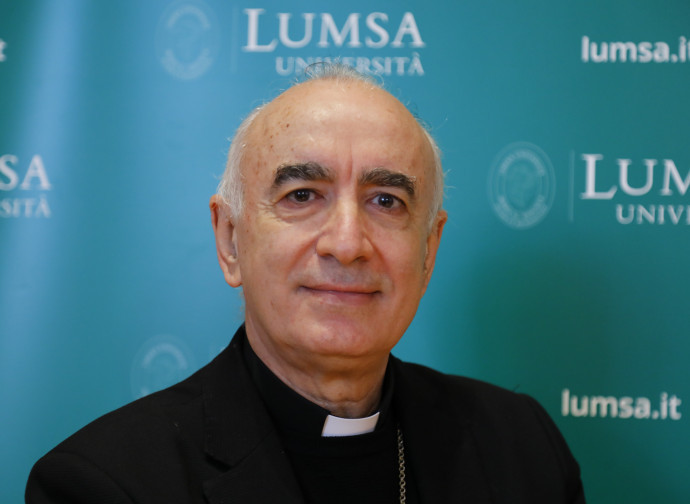Read Staglianò to understand opposition to Mary 'Coredentrix'.
The president of the Pontifical Academy of Theology unilaterally highlights the 'dissimilarity' between Mary and Christ. He deserves credit for bringing to light the intellectual leap underlying the Note on Marian Titles. Essentially, it is better to prevent anyone from taking the great things the Almighty has done for Christ’s mother too seriously.

We must be particularly grateful to Msgr. Antonio Staglianò, President of the Pontifical Theological Academy, because he has the merit of having brought to light what had remained in the background in the Doctrinal Note Mater Populi Fidei. Because in the background, it is only in §74 that we find the true essence of the document, where Pope Francis's audience on 24 March 2021 is reported. During this audience, the Pope stated that Mary 'is more disciple than Mother'.
During the audience, Francis elaborated, stating that being a humble handmaid 'is the role that Mary occupied throughout her earthly life and that she retains forever: to be the Lord's humble handmaid, nothing more'. This 'nothing more' raises more than one problem. So does the subsequent statement that all the titles attributed to the Blessed Virgin by the Fathers, Saints and Liturgy are merely ‘expressions of love, like a son to his mother – sometimes exaggerated’.
In a recent article in L'Osservatore Romano, Msgr. Staglianò takes a more articulate and complex approach, but still misunderstands the mystery of Mary. "The analogy by similitude," he explains, "instinctively leads [...] to the birth of 'salvific parallelism'", which minimises dissimilarity. In this process, the abysmal difference — Christ acts as God and man, the first and autonomous source of grace, whereas Mary acts as a redeemed and transformed creature, a derived and subordinate channel — is flattened. Dissimilitude becomes an appendix, a footnote".
Therefore, the time has come to abandon the title 'Co-redemptrix', the result of a 'misapplied analogy', and the 'end of the line' for this approach. This approach would lead to a parallelism between Christ and Mary in the work of salvation. Instead, we should embrace an 'Analogy Reversed', which recognises the fundamental and irreconcilable differences between Christ and Mary. This approach concludes that 'Mary's role is not in 'redeeming with' Him, but in being a creature completely transformed by the Redemption, becoming the clearest symbol of its effectiveness'. Therefore, abandoning 'Coredemptrix' is a gain in depth, not a loss. In the light of the Reversed Analogy, Mary ceases to be a 'quasi-Christ' in a dangerous salvific parallelism. Instead, she becomes the icon of creaturely dissimilarity before God. Free of so many resounding words, Mary is simply a creature: holy, obedient and humble, but 'nothing more' than a creature, as Francis desired, burying Dante's 'higher than creaturely' memory.
The first question to ask Msgr. Staglianò is why the title 'Co-Redemptrix' favours a similarity that ignores dissimilarity. The prefix 'co' in the term 'Co-Redemptrix' stands for 'cum' and indicates an association with the work of another without establishing any parallelism or affirming perfect equality. This is how it has always been understood in the texts of the Magisterium, by the saints and theologians. And in this context, what should we think of the letter to the Colossians, where St Paul states that Christians are literally con-sepolated with Christ in baptism and con-resurrected by faith (cf. Col 2:12)? Did the Apostle perhaps forget the dissimilarity and obscure the uniqueness of Christ by using the prefix 'συν-' (= 'cum', 'co-')? Or did he intend to nullify the difference with Christ when he referred to himself and the other apostles as God's 'co-workers' (cf. 1 Cor 3:9; literally 'συν-εργός', 'co-operator', 'coadjutor')?
However, the criticism of Staglianò's article is intended to be more radical because we realise that it is not simply the title 'Co-redemptrix' that bothers us, but the doctrine it contains. In affirming the dissimilitude between Christ and Mary, he does not deny Our Lady's active role, but fails to grasp its peculiarity. To understand this, we must recognise the uniqueness and singularity of her person. While it is true that she does not have a divine nature and therefore lacks the grace that derives from the hypostatic union — a unique and incommunicable characteristic of the Incarnate Word — it is also true that she has been elevated to a higher order than any other spiritual being, whether human or angelic. In practice, Msgr. Staglianò fails to realise that the 'maior' dissimilitudo between Christ and Mary is only one part of the argument because there is also a 'minor' dissimilitudo. As the Immaculate Mother of God, Mary Most Holy is elevated to the hypostatic order — though this does not mean she enjoys the hypostatic union — placing her immeasurably above every creature, saint and angel.
She is not just a 'great saint', but the Immaculate Mother of God, full of grace. Her merits in her association with the Lord's redemptive work, particularly on Calvary, are of almost infinite value, because it was not just any woman or mother who suffered there, but the Immaculate Mother of God. She belongs to a unique order, inferior to the hypostatic union of the Son but superior to all natural and supernatural orders, by virtue of her special relationship with the Incarnate Word. It is precisely because she belongs to the hypostatic order by virtue of her divine maternity that she can be called Co-redemptrix. This is not an independent and parallel collaboration to that of Christ, but a co-redemption provoked and exercised jointly with Him.
This singular order to which the Mother of God has been elevated is not her own doing; she received it from the superabundance of Trinitarian love. The fact that Our Lady participates in a unique way in her Son's redemptive work, for which reason we call her Coredemptrix, does not diminish the uniqueness of the Redeemer. This is because Mary's redemption is a gift from God, not her own merit. It is a unique participation because God, in his wise benevolence, wanted it and elevated her above all other creatures, placing her in a sphere that touches the divine. This prepares a new companion for the new Adam in the work of recapitulation.
It is precisely because of this singularity that she is not only the true Coredemptrix, but also the Mediatrix of all graces. When St Thomas bases Christ's mediatorial being on his humanity (cf. Summa Theologiae, III, q. 26, a. 2), he highlights the two key attributes of a mediator: drawing 'from God by nature and from men by the dignity of grace and glory' and uniting 'God and men among themselves'. These characteristics belong by nature to the Man-God and are also attributable to the Mother of the Incarnate Word by participatory analogy and as a divine gift. She is detached from God by nature — that is, her humanity — and also from men, by virtue of the privilege of having been elevated to the hypostatic order as the Mother of a Person who possesses both divine and human natures. At the same time, she unites these two 'polarities' because she is both fully human and fully divine, even though she does not possess the divine nature. Once again, she exists because of her unique union with the Incarnate Word, and is therefore dependent on Him.
Unfortunately, Staglianò's note and article do not adequately address Mary's mystery. Her status as an 'icon of dissimilitude' is examined solely in relation to God, ignoring her unique position above the order of creation, grace, and glory. Consequently, Staglianò paradoxically belittles God's power by reducing the great things the Almighty has done for her.




